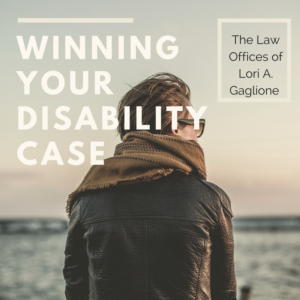Social Security has an impairment listing for anxiety disability determinations.
Impairment listing 12.06 Anxiety-Related Disorders provides the medical criteria needed to meet the severity requirement of disability.
The anxiety disorder must be either a predominant disturbance or experienced when the individual attempts to overcome symptoms. For instance, when an individual is confronting a dreaded object or situation in a phobic disorder, or when resisting obsessions or compulsions in obsessive compulsive disorders.
A. You must have a medically documented finding of at least one of the following:
1.Generalized persistent anxiety along with three out of four of the following symptoms:
a. Motor tension
b. Autonomic hyperactivity
c. Apprehensive expectation
d. Vigilance and scanning
2. Persistent irrational fear of a specific object, activity, or situation that results in a compelling desire to avoid the dreaded object, activity or situation.
3. Recurrent severe panic attacks demonstrated by a sudden unpredictable onset of intense apprehension, fear, terror, and sense of impending doom occurring on the average of at least once a week.
4. Recurrent obsessions or compulsions that are a source of severe distress.
5. Recurrent and intrusive recollections of a traumatic experience, which is a source of extreme distress.
AND
B. Resulting in at least two of the following.
1. marked restriction of activities of daily living
2. marked difficulties in maintaining social functioning
3. marked difficulties in maintaining concentration, persistence, or pace
4. repeated episodes of decompensation, each of extended duration.
OR
C. Resulting in complete inability to function independently outside the area of one’s home.
There are several ways your anxiety condition can meet or equal the severity of the anxiety impairment listing. A well documented history of medical treatment for anxiety that includes a diagnosis, prognosis, response to medication, and an opinion as to the limitations caused by your anxiety will be most helpful for your disability claim.
It should be pointed out, though, that most individuals who are approved for SSD or SSI are not approved through a listing as listing requirements are very specific.
If you cannot be awarded disability for anxiety through the listing, it may be possible to win benefits after an evaluation of your medical history and work history. The work history would be examined to find out what your past jobs required of you both physically and mentally to determine A. your skills and B. whether those skills transfer to other kinds of jobs. Your medical history is assessed to learn what you are still functionally capable of doing. This is known as residual functional capacity.
If your current limitations are more than what your past work required you to do, it is possible to be approved for disability. The evaluation of your claim, however, would also have to show that your skills do not transfer to other types of work. This type of approval is called a medical vocational allowance.
Anxiety disorder is a nervous system disorder that affects the emotional state. Anxiety disorder causes anxious, fearful emotions that are usually thought of as irrational, meaning they are worries that are not based on factual information.
The cause of anxiety disorder is not fully understood. Doctors think the cause is linked to neurotransmitters in the brain, such as norepinephrine and serotonin, but they also acknowledge that it is likely that anxiety disorder stems from an intricate web of causes including genetics, environment, life experiences and the body’s biological processes.
The signs and symptoms of anxiety disorder are quite varied, from irritability, muscle tension, shortness of breath, stomachache, feeling on edge and being easily distracted to diarrhea, panic attacks and headache. Many people experiencing anxiety disorder feel extremely anxious, as if an impending ‘doom’ is right around the corner, as if something bad is about to happen though there is no reason for the fear.
The term anxiety disorder covers a variety of different types of disorders; the most common are generalized anxiety disorder, obsessive-compulsive disorder (OCD), panic disorder, social anxiety disorder and post-traumatic stress disorder.
General anxiety disorder is when the worries and fears are general and not focused on one particular object, event or reason.
Panic disorder is diagnosed when the patient suffers ‘attacks’ of intense terror that cause dizziness, difficulty breathing, shaking, confusion and nausea. These attacks usually last ten minutes or less, but can sometimes last much longer.
Social anxiety disorder, also known as social phobia, is when the fear of being embarrassed or humiliated causes extreme anxiety, sometimes to the point that normal life is interrupted. Many with social anxiety disorder do not want to leave the house for fear of being judged negatively by society.
Obsessive-compulsive disorder is an anxiety disorder that is marked by repetition and ritualistic behavior. Usually this obsession or compulsion is a way to relieve anxiety or nervousness. Those with obsessive-compulsion disorder often have upsetting and repetitive thoughts and images play in their mind. Many times they feel compelled to do certain things in certain ways to keep bad things from happening. Often this will include common things like checking to make sure the door is locked, obsessing over personal items or arranging things in a certain way.
Post-traumatic stress disorder is an anxiety disorder that is usually the result of a traumatic experience, from warfare or violence to extreme stress. Those with the disorder may avoid certain places or things in order to not increase their anxiety.
Diagnosis for anxiety disorder includes an assessment/questionnaire, family history, reports from the patient and a medical examination. Those with anxiety disorder oftentimes also have symptoms of clinical depression and vice-versa. Treatment can include congnitive behavioral therapy and/or medications such as anti-anxiety medication, antidepressants and beta-blockers. Some people choose natural and alternative treatments such as acupuncture, hypnotherapy and relaxation techniques.
To help prevent anxiety disorder get plenty of rest, eat a balanced, healthy diet, engage in physical activity, eliminate caffeine, avoid alcohol and drugs and take time to relax and de-stress. Some people report that yoga, meditation, deep breathing exercises and relaxation techniques have helped their anxiety.
If you have questions we can help!
Source: https://www.ssdrc.com/condition-anxiety-disorder.html


